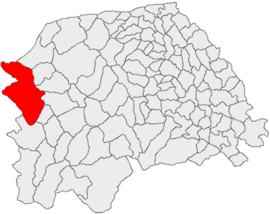Cârlibaba facts for kids
Quick facts for kids
Cârlibaba
|
||
|---|---|---|

Cârlibaba in July 2009
|
||
|
||

Location in Suceava County
|
||
| Country | ||
| County | Suceava | |
| Population
(2011)
|
Lua error in Module:Wd at line 1,575: attempt to index field 'wikibase' (a nil value). | |
| Time zone | EET/EEST (UTC+2/+3) | |
Cârlibaba (German: Mariensee, Ludwigsdorf, or Kirlibaba; Polish: Kirlibaba) is a commune located in Suceava County, Bukovina, northeastern Romania. It is composed of six villages, namely: Cârlibaba (Veche; also the commune seat), Cârlibaba Nouă, Iedu (German: Jedt), Șesuri (German: Schessu), Țibău (German: Zibau), and Valea Stânei (German: Hüttenthal bei Mariensee).
Contents
Other names
In standard German (i.e. Hochdeutsch), Cârlibaba Veche is known as Mariensee whereas Cârlibaba Nouă is known as Ludwigsdorf.
Demographics
At the 2002 census, 85.3% of inhabitants were Romanians, 9% Germans (more specifically Bukovina Germans and Zipser Germans), and 5.4% Ukrainians. 85.8% were Romanian Orthodox and 13.1% Roman Catholic.
At the 2011 census, 89.05% of inhabitants were Romanians, 5.07% Germans (more specifically Bukovina Germans and Zipser Germans) and 4.08 Ukrainians. For the rest of 1.81% inhabitants, their ethnicity was registered as unknown. 84.8% were Romanian Orthodox and 12.17% Roman Catholic. For the rest of 1.81% inhabitants, their religious confession was registered as unknown.
History
![]() Moldavia (1388–1775)
Moldavia (1388–1775)
![]() Habsburg Monarchy (1775–1804)
Habsburg Monarchy (1775–1804)
![]() Austrian Empire (1804–1867)
Austrian Empire (1804–1867)
![]() Austria-Hungary, Cisleithania (1867–1918)
Austria-Hungary, Cisleithania (1867–1918)
![]() Kingdom of Romania (1918–1947)
Kingdom of Romania (1918–1947)
![]() Romanian People's Republic (1947–1965)
Romanian People's Republic (1947–1965)
![]() Socialist Republic of Romania (1965–1989)
Socialist Republic of Romania (1965–1989)
![]() Romania (1989–present)
Romania (1989–present)
Along with the rest of Bukovina, Cârlibaba formed part of the Principality of Moldavia until 1774, when it was occupied by Russia, and soon handed over to Austria. Under Austria and Austria-Hungary, the commune was inhabited by a sizeable number of Zipser German mining colonists (part of the broader Bukovina German community of the historical region of Bukovina and Suceava County).
During World War I, on 18–23 January 1915, it was the site of a battle between the Polish Legions and Russian troops, won by the Poles. A memorial to the fallen Polish soldiers was erected in 1932 near the Saint Louis church.
Gallery
-
The house on the rock (Romanian: Casa de pe stâncă)
See also
 In Spanish: Cârlibaba para niños
In Spanish: Cârlibaba para niños












